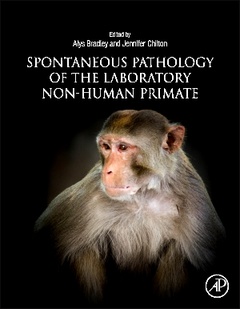Spontaneous Pathology of the Laboratory Non-human Primate
Coordonnateurs : Bradley Alys, Chilton Jennifer, Mahler Beth

Pathologists often face a lack of suitable reference materials or historical data to determine if pathologic changes they are observing in monkeys are spontaneous or a consequence of other treatments or factors.
2. Choice of Primate species
3. Regulatory issues in the use of primates
4. Infectious Diseases
5. Clinical Examination
6. Salivary glands
7. Oral Cavity
8. Esophagus and Stomach
9. Small and Large Intestine
10. Liver
11. Exocrine Pancreas
12. Kidney
13. Urinary bladder, ureter, urethra
14. Brain
15. Spinal Cord and Nerves
16. Eye and associated glands
17. Skeletal Muscle
18. Bone and Joints
19. Skin and subcutis
20. Specialized sebaceous glands
21. Mammary Gland
22. Respiratory tract
23. Immune System
24. Bone Marrow
25. Female Reproductive Tract
26. Testis
27. Male sex glands
28. Heart
29. Blood Vessels
30. Thyroid
31. Parathyroid
32. Pituitary
33. Adrenal
34. Endocrine Pancreas
35. Hematology
The primary audience is veterinary toxicologic pathologists working in the field of safety assessment in pharmaceutical or agrochemical fields. The book could also serve as a reading list text for veterinarians studying for:
- Pathology board exams – Diploma of the American College of Veterinary Pathology, Diploma of the European College of Veterinary Pathology, Diploma of the Japanese College of Veterinary Pathology, Diploma of the Japanese Society of Toxicological Pathology, Fellowship of the Royal College of Pathologists
- Laboratory Animal Medicine Diploma exams (European and American)
- Undergraduate Veterinary exams – exotic/zoo animal medicine
And also serve as a reference text for Veterinarians working as Zoo clinicians
Dr. Chilton has been with Charles River since 2007 where she is the senior veterinary pathologist. She has specialist interest and provides consultancy services in neuropathology, non-human primate and comparative pathology. She has authored numerous GLP and investigative toxicological reports and is currently the neuropathology liaison to The National Chimpanzee Brain Resource (NCBR), George Washington University, Washington DC and staff pathologist for the Alamogordo Primate Facility, Alamogordo, NM.
Ms. Mahler is a Pathology Associate with over 32 years of experience as a certified histologist (HT) in the areas of histology, animal necropsy, and digital photomicroscopy. Since 2006, she has served as the illustrations editor for the journal Toxicologic Pathology. Past illustrative editorship roles include associate editor of Pathology of the Mouse, edited by Dr Robert R. Maronpot.
- Contains color illustrations that depict the most common lesions to augment descriptions
- Covers descriptions that are compliant with the International Harmonization of Nomenclature and Diagnostic Criteria (INHAND) guidelines set forth by the Society of Toxicologic Pathology (STP)
- Provides pathologists with common terms that are compliant with the FDA’s Standard for Exchange of Nonclinical Data (SEND) guidelines
Date de parution : 07-2023
Ouvrage de 626 p.
21.5x27.6 cm
Thème de Spontaneous Pathology of the Laboratory Non-human Primate :
Mots-clés :
Acute pancreatitis; Adenocarcinoma; Administration; Adnexa; Amyloidosis; Anatomy; Animal models; Animal use alternatives; Artifacts; Bacteriology; Bone; Brain; Callithrix; Callithrix jacchus; Carcinoma; Checklist; Cheilosis; Chemotherapy; Cleft palate; Clinical examination; Clinical pathology; Colitis; Comparative systems biology; Coronavirus; Cortex; CRISPER/Cas9; Cynomolgus; Degeneration; Disease; Diverticulosis; EMEA; Enteral; Enteritis; Esophagitis; Esophagus; Ethics; Exocrine; Eye; Eyelid; FDA; Fibromatosis; Ganglia; Gastritis; Gastroenteritis; Gingivitis; GIST; Glomerulus; Glossitis; Gluten; Histology; Histopathology; IACUC; Infectious; Inhalation; Japan Brain/MINDS; Joint; Kidney; Lacrimal gland; Large intestine; Leiomyoma; Leiomyosarcoma; Leukoplakia; Liver; Macaca; Macaca fascicularis; Macaca mulatta; Macaque; MALT; Marmoset; Meckel's diverticulum; Medulla; Megaesophagus; Meibomian; Monkey; Muscle; Musculoskeletal; Neoplasia; Nephron; Nerves; NHP; Noma; Non-human primate



